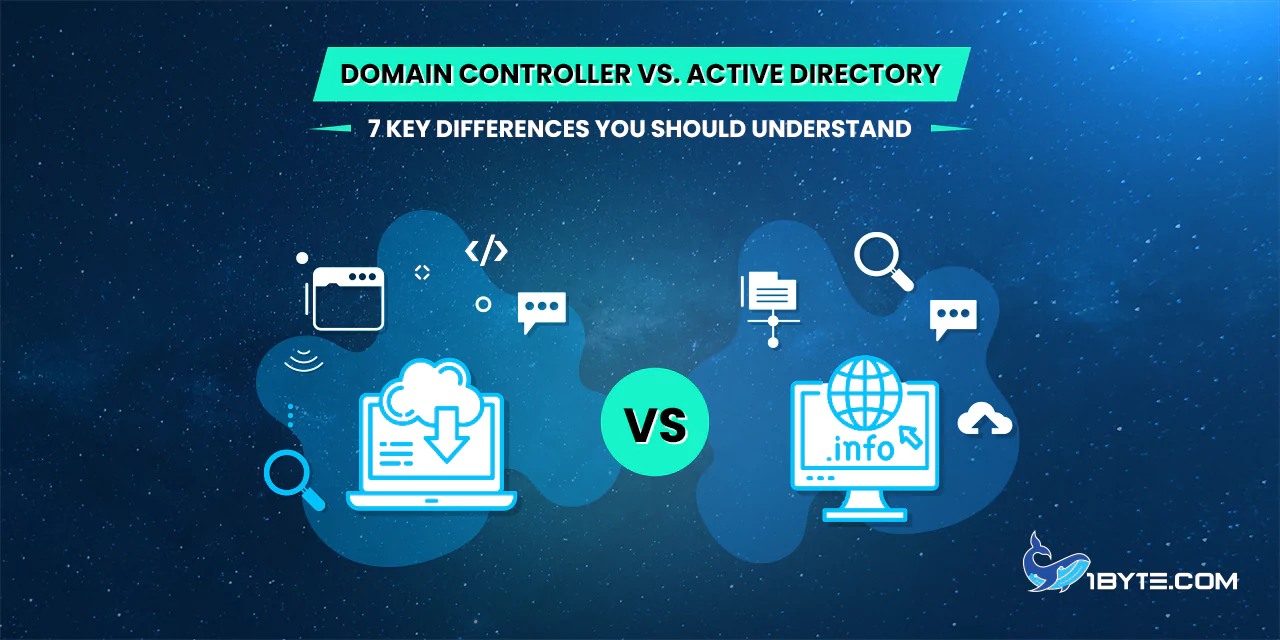Are you perplexed by the terms Domain Controller and Active Directory? Don’t worry, we’ve got your back! In this article, we’ll explain the seven significant differences between Domain Controller vs Active Directory. So, let’s get started and obtain a solid understanding of these critical network administration components through a thorough comparison.
An Overview
In this first section, we’ll provide you a detailed introduction of these two critical network administration components.
1. Domain Controller
A Domain Controller is a server that responds to user authentication requests and grants the host access to various enterprise network services. It serves as a gatekeeper by verifying user credentials and giving or refusing access to resources inside its domain.
Domain Controllers are in charge of managing resource access inside a specified domain. They validate user credentials and give access to domain resources. As a result, whereas Active Directory handles the general picture of several domains, Domain Controllers handle the specifics of access within a single domain.
2. Active Directory
Active Directory (AD) is Microsoft‘s proprietary directory service that enables IT teams to manage identities and secure access to organizational network resources. It functions similarly to a phone book in that it saves information on users, computers, and other resources.

The overall structure of the directory network is provided by Active Directory. It establishes the rules and structure for controlling network identification and access. This involves overseeing several domains, each with its own set of Domain Controllers.
3. Why They Are Important
Domain Controller and Active Directory are crucial because they provide critical capabilities for controlling network identity and access. Active Directory establishes the overarching structure for managing identity and access, while Domain Controllers handle authentication and permission details.
They operate together to give a comprehensive solution for managing network resource access. This includes limiting who has access to what resources and establishing rules for how those resources can be used. IT teams may assure the security of their network and the proper amount of access to resources by utilizing Domain Controller and Active Directory.
Recommended reading: How to Register Domain Name on 1Byte?
7 Differences Between Domain Controller vs Active Directory
Now that we got the definitions out of the way, let’s delve into it further. Let’s look at the primary differences between Domain Controller vs Active Directory to understand their distinct functions. Understanding these distinctions will enable you to make more informed network management decisions. So, without further ado, let’s look at the seven distinct features that distinguish Domain Controllers vs Active Directory.
1. Function
A Domain Controller’s role is to authenticate and allow user access to network resources. It serves as the central authentication authority and keeps user account information. In contrast, Active Directory is a directory service that organizes and maintains network resources. It offers a centralized database for storing and retrieving data on network objects including users, groups, and computers.
While a Domain Controller focuses on user authentication, Active Directory provides a broader range of services such as group policy management, software distribution, and network-wide security settings. In short, a Domain Controller is in charge of user authentication, whereas Active Directory is in charge of managing a wide range of network resources and services.
2. Structure
The overall structure of the directory network is provided by Active Directory. It functions similarly to a phone book in that it saves information on users, computers, and other resources. Domain Controllers, on the other hand, control access to domain resources. They serve as gatekeepers, verifying user credentials and authorizing resource access.
In other words, Active Directory is the overall picture, and Domain Controllers are in charge of the details. Consider it like a city map. Active Directory serves as the map, displaying all of the different neighborhoods and streets. Domain Controllers function similarly to traffic cops, directing traffic and ensuring that everyone gets where they need to go.
3. Domains
Another significant distinction between Domain Controller vs Active Directory is how they manage domains. Active Directory supports numerous domains, each with its own set of Domain Controllers. This means that separate domains can be created for different departments or locations, all managed by Active Directory.
Domain Controllers, on the other hand, are in charge of managing resource access within a single domain. They validate user credentials and give access to domain resources. As a result, whereas Active Directory handles the general picture of several domains, Domain Controllers handle the specifics of access within a single domain.
| FURTHER READING: |
| How to Sell Your Domain Name Effectively: An 8-Step Guide |
| What is an Email Domain: A Closer Look |
| How to Set Up a Gmail Custom Domain: A Step-by-Step Guide |
4. Server
The server that runs Active Directory is known as a Domain Controller. The Domain Controller is the physical machine that runs the Active Directory software.
To put it another way, Active Directory is the software and the Domain Controller is the hardware. Consider it like an automobile. Active Directory functions similarly to an engine, delivering power and functionality. The Domain Controller, like the automobile, provides the physical structure for the engine to be held and run.
5. Authentication
A Domain Controller authenticates individuals and machines who wish to join the domain. When a user attempts to access resources within a domain, the Domain Controller verifies their credentials and provides or denies access.

In contrast, Active Directory provides the general structure for managing identity and access. It saves user and resource information and lets IT teams define what users can do on the network. So, although the Domain Controller handles the actual authentication, Active Directory establishes the rules and structure for access management.
6. Services
Active Directory is made up of four core services that allow it to manage identity and access: Active Directory Domain Services (AD DS), Active Directory Lightweight Directory Services (AD LDS), Active Directory Federation Services (AD FS), and Active Directory Certificate Services (AD CS).
These services work in tandem to provide a comprehensive solution for network identification and access management. AD DS holds directory information and manages resource access. Multiple instances of the directory service can run on the same server with AD LDS. AD FS enables single sign-on, whereas AD CS creates and administers digital certificates.
A Domain Controller, on the other hand, does not provide these additional functions. Its primary function is to authenticate users and give access to domain-specific resources.
7. Access
By authenticating and approving users based on their login credentials, a Domain Controller restricts access to enterprise resources inside a specified domain. This signifies that the Domain Controller verifies user credentials and provides or refuses access to domain resources.
In contrast, Active Directory provides the general structure for managing identity and access. It saves user and resource information and lets IT teams define what users can do on the network. As a result, although the Domain Controller handles the actual authentication and authorization process, Active Directory establishes the rules and structure for access management.
FURTHER READING: |
1.9 Tips For How to Choose the Best Domain Name For Your Website |
2. What Is DNSSEC? What It’s the Pros and Cons? |
Leverage 1Byte’s strong cloud computing expertise to boost your business in a big way
1Byte provides complete domain registration services that include dedicated support staff, educated customer care, reasonable costs, as well as a domain price search tool.
Elevate your online security with 1Byte's SSL Service. Unparalleled protection, seamless integration, and peace of mind for your digital journey.
No matter the cloud server package you pick, you can rely on 1Byte for dependability, privacy, security, and a stress-free experience that is essential for successful businesses.
Choosing us as your shared hosting provider allows you to get excellent value for your money while enjoying the same level of quality and functionality as more expensive options.
Through highly flexible programs, 1Byte's cutting-edge cloud hosting gives great solutions to small and medium-sized businesses faster, more securely, and at reduced costs.
Stay ahead of the competition with 1Byte's innovative WordPress hosting services. Our feature-rich plans and unmatched reliability ensure your website stands out and delivers an unforgettable user experience.
As an official AWS Partner, one of our primary responsibilities is to assist businesses in modernizing their operations and make the most of their journeys to the cloud with AWS.
Conclusion
Indeed, there are numerous crucial differences to comprehend when it comes to Domain Controller vs Active Directory. The broad structure for managing identity and access on a network is provided by Active Directory, while Domain Controllers handle the intricacies of authentication and permission.
They operate together to give a comprehensive solution for managing network resource access. IT teams may better manage their network and ensure that users have the proper amount of access to resources by understanding the distinctions between Domain Controller vs Active Directory.
1Byte hopes this post has clarified the essential distinctions between Domain Controller vs Active Directory. Understanding these distinctions allows you to make educated decisions about how to manage identity and access on your network.

